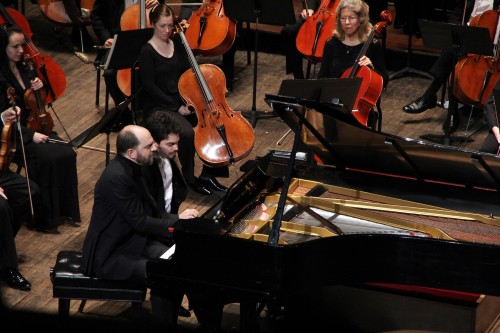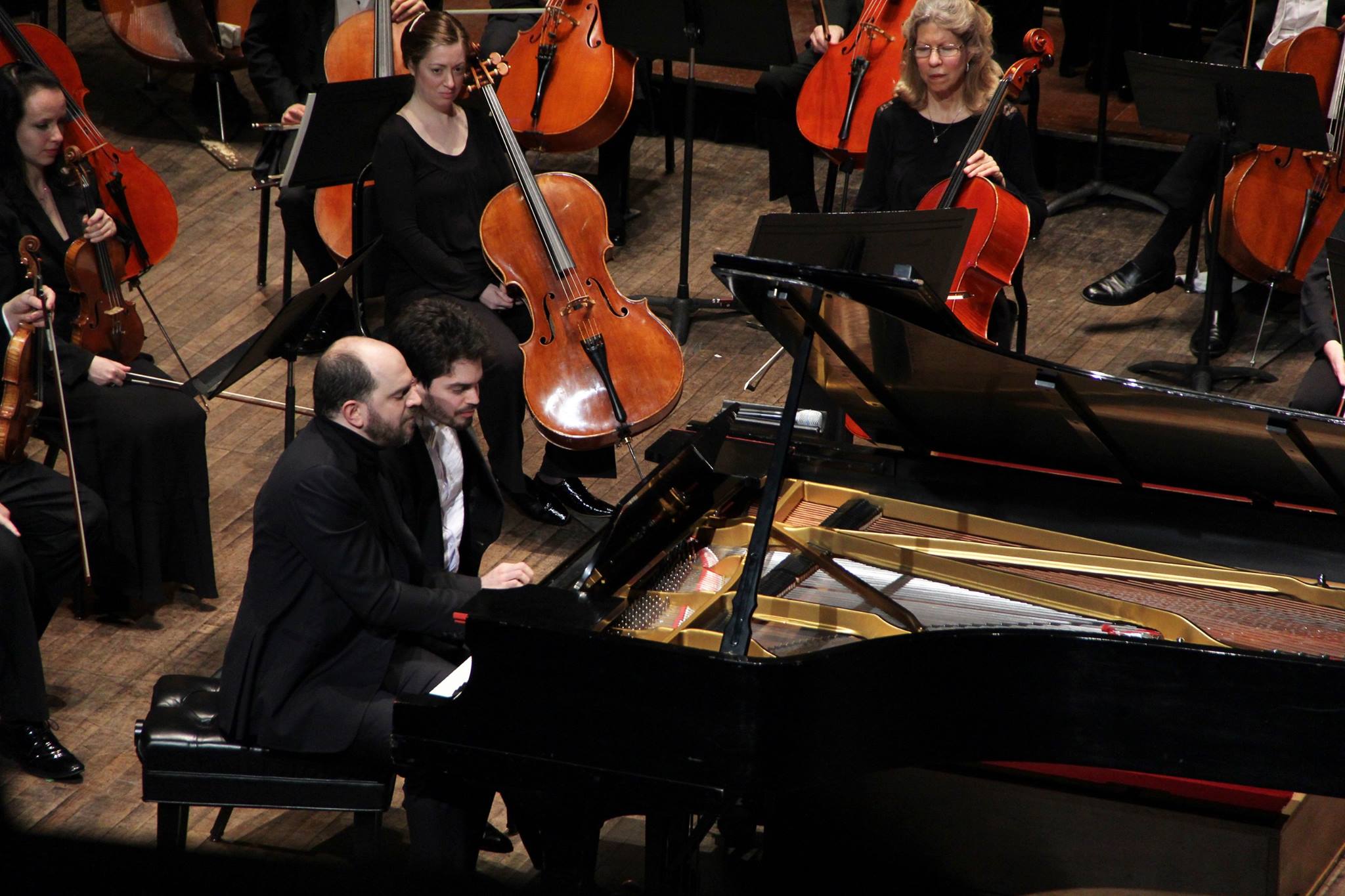 Canada Brahms, Schoenberg: Kirill Gerstein (piano), Vancouver Symphony Orchestra/Lahav Shani (conductor), Orpheum Theatre, Vancouver, 18.2.2016. (GN)
Canada Brahms, Schoenberg: Kirill Gerstein (piano), Vancouver Symphony Orchestra/Lahav Shani (conductor), Orpheum Theatre, Vancouver, 18.2.2016. (GN)

Brahms – Piano Concerto No.1 in D minor Op.15
Schoenberg – Pelleas and Melisande Op.5
Brahms: Garrick Ohlsson (piano), Vancouver Symphony Orchestra/Bramwell Tovey (conductor), Chan Centre, Vancouver, 25.2.2016. (GN)
Brahms – Piano Concerto No.2 in B-flat major Op.83; Symphony No.2 in D major Op.73; Hungarian Dance No.4 in F-sharp minor (orch. Paul Juon)
The Vancouver Symphony may not have intended to create a mini-Brahms Festival at this time of the year, but with Kirill Gerstein arriving to play the First Piano Concerto and, a week later, Garrick Ohlsson taking on the Second, it certainly felt like a celebration of sorts. Brahms’ Second Symphony was also part of the mix; Schoenberg’s Pelleas and Melisande might have looked like the outlier but this composer’s immense debt to Brahms is well documented. The obvious insight gained is that there is that there are a variety of ways to play the Brahms concertos: Gerstein more volatile and lyrical, Ohlsson firmer and more patrician. Both types of pianism were illuminating; the only thing that may have militated against the performances was that the respective orchestral collaborations were not as finely tuned as they might have been.
I’ve always found the Brahms First Concerto more firmly anchored in stone than other concertos, allowing room for rhapsodic freedom but never so much as to belie its origins as a tightly-constructed symphony. One finds this structural strength in the classic performances of Gilels, Curzon and Kovacevich, though ample poetry abounds too. Kirill Gerstein challenged this model, cultivating a lyrical flow that seemed to spawn spontaneous waves of feeling, often venturing to the caprice and volatility of Schumann and the fervour of Liszt. There is always a natural rubato and ‘swing’ in his lines, often suspending the beginning of a phrase and then pushing it out with contrasting dynamics and motion; there is also a beguiling playfulness that combines with his poetic sensitivity. All this was put to interesting use here.
Gerstein’s opening Maestoso was rhapsodic indeed, the pianist weaving and thrusting to newly-minted corners of expression. I may have missed the quiet ruminative undercurrent and sheer ‘doggedness’ of Brahms’ writing, but the effervescence of this treatment was refreshing. There were certainly moments of fury unleashed, and the wistful undercurrent was transformed into something more ominous and demonic. Perhaps some pushes and pulls distracted from the movement’s pulse but Gerstein managed to bring everything together, and his bravura at the end was scintillating. The Adagio started at a slightly faster pace than usual, establishing unusual variety in the line, and eventually descended to beautifully delicate and intimate musing towards the movement’s close. The pianist’s rubato was a little pronounced in the middle of this movement and some moments of rhythmic push seemed overwrought, but one can accept these in context. Gerstein infused the closing Rondo with plenty of life and jump – emphasis on the latter – building to the close with real Brahmsian reach and elevation of line. I would single out the playing at the end of the last two movements as at the absolutely highest level of sensitivity and understanding.
Gerstein’s collaborator was the estimable young Lahav Shani, who was just appointed Principal Conductor of the Rotterdam Philharmonic and has received strong press internationally. One has to be impressed with the thought with which the conductor sets up his orchestra: divided violins, lower strings on the left, and so on. And the strong burnished sound that he achieves would be the envy of any conductors just entering their thirties. Unfortunately, I found his main concern was about getting ‘sound’ out of the orchestra, rather than adjusting to the novelties of Gerstein’s approach. Every climax was volcanic, every wind phrase was fashioned just so, and even the strings were coaxed to an effusive gloss and weight that would have made Herbert von Karajan proud. One witnessed strong orchestral control indeed, but the rendering was too generalized and heavy to fit with Gerstein’s varied, and often lighter, fabric. I wished that the conductor would find a more flexible response; his propensity to seek ‘effects’ (e.g., inject an accelerando into the tutti half way through the finale) did not help. For the encore, Gerstein and Shani both sat down amiably at the piano for a delightful Schoenberg-arranged version of the Barber of Seville overture, so perhaps it was me who worried most about the issues.
The other work on this programme was Schoenberg’s Pelleas and Melisande, an adventurous choice of a piece not often performed in concert, though John Storgårds gave Zemlinsky’s Die Seejungfrau here a year ago. Both compositions were premiered at the same concert in Vienna in 1905. Shani gave a well-played, cogent account which stressed the integration and development of the work’s constituent three-note motives but was light on dramatic differentiation and sensual variety. The strong, burnished weight of the orchestra’s output was again notable, and I’ve never seen the horns placed up so close on the right side of the stage floor.
Taking place in the smaller Chan Centre, Garrick Ohlsson’s performance of Brahms’ Second Piano Concerto was much more conventional than Gerstein’s treatment of the First, yet the pianist provided absolutely patrician playing, full of subtle articulation and wisdom. As might be expected from this revered artist, it was a reading that accented power and architectural strength, but it would be remiss not to note all the wonderfully feathered runs and textures that charmed alongside. I first saw Ohlsson in the mid-1970s, and it’s amazing how much insight and natural virtuosity he has preserved over four decades. I probably like his playing even more today.
Ohlsson’s first two movements were admirably judged, indeed fully etched in stone and rhythmically astute, with a keen ability to bring the music forward with élan just when it needed it. The solidity and cleanness of his piano tone was a consistent delight. In the Adagio, the pianist complemented Janet Steinberg’s sensitive solo cello with playing of the loveliest repose, searching and inward, while the finale cultivated all the easeful play and charm that one could desire. This was wonderfully cohesive playing, and perhaps the only thing missing was slightly more sense of lyrical fragrance, and a more suspended arch to the phrasing, in the long opening movement. Bramwell Tovey’s conducting did not really impart this dimension: it seemed to relish passages of dramatic attack over those of expressive ardour and foster insistent speeds. The orchestra also might have been quieter and more concentrated at the end of the Adagio. I recognize that this venue does not allow the full orchestral sound to project that clearly; it becomes somewhat gluey with an over-modulated bass. That might have been a problem, but this still turned out as a most worthwhile performance from a master.
Tovey’s Brahms Second Symphony closed the concert creditably, finding integration and strength in the long first movement (repeat taken) but also seeming slightly breezy at its quick pace. The playing was most deeply felt in the Andante but, unfortunately, the orchestra got out of step towards the end. The finale was a bit too rhythmically charged for my taste, but the brass really outdid themselves.
A most rewarding mini-festival overall, and it was both intriguing and nourishing to hear such contrasting approaches to the two great concertos.
Geoffrey Newman
Previously published in a slightly different form on http:// www.vanclassicalmusic.com.
